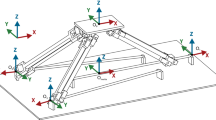Abstract
Typical mobile robots can be modeled as parallel mechanisms by employing an interfacing variable between the ground and the wheels. Based on this conception, the screw theory was employed in the following work as an alternative approach in the modeling of such parallel-natured mobile robots. This theory allows for a geometric analysis of mobile mechanisms. As a result, the computational load in the derivation of a Jacobian model can be reduced, the kinematic model for different sets of inputs can be easily obtained, and an equivalent serial-chain model can be analyzed. Two mobile robots were examined as exemplary models. The proposed approach can also be applied to kinematic modeling and the analysis of general types of mobile robots.
Similar content being viewed by others
References
P. F. Muir and C. P. Newman, “Kinematic modeling of wheeled mobile robot,” Journal of Robotic System, vol. 4, no. 2, pp. 281–340, 1987.
S. K. Saha and J. Angeles, “Kinematics and dynamics of a three-wheeled 2-DOF AVG,” Proc. IEEE Int. Conf. on Robotics and Automation, pp. 1572–1577, 1989.
C. Campion, G. Bastin, and B. D’Andrea-Novel, “Structural properties and classification of kinematics and dynamics models of wheeled mobile robot,” IEEE Trans. on Robotics and Automation, vol. 4, no. 2, pp. 281–340, 1987.
D.-S. Kim, W. H. Kwon, and H. S. Park, “Geometric kinematics and applications of a mobile robot,” Int. J. Control, Automation, and Systems, vol. 1, no. 3, pp. 376–384, 2003.
B.-J. Yi and W. K. Kim, “Kinematic modeling of omnidirectional mobile robots as parallel manipulator,” Journal of Robotic Systems, pp. 172–178, 2003.
W. K. Kim, B.-J Yi, and D. J. Lim, “Kinematic modeling of mobile robots by transfer method of augmented generalized coordinates,” Journal of Robotic Systems, vol. 21, no. 6, pp. 301–322, 2004.
J. H. Chung, B.-J. Yi, W. K. Kim, and S.-Y. Han, “singularity-free dynamic modeling including wheel dynamics for an omni-directional mobile robot with three caster wheels,” Int. J. Control, Automation, and Systems, vol. 6, no. 1, pp. 88–100, 2008.
J. Duffy, Statics and Kinematics with Applications to Robotics, Cambridge University Press, Cambridge, 1995.
R. S. Ball, A Treatise on the Theory of Screws, Cambridge University Press, Cambridge, 1900.
U.-K. Lee and C.-S. Han, “A method for predicting dynamic behaviour characteristics of a vehicle using the screw theory -part 1,” Proc. of the Institution of Mechanical Engineers, Part D, Journal of Automobile Eng., vol. 222, no. 1, pp. 65–77, 2008.
J. Wit, C. D. Crane, and D. Armstrong, “Autonomous ground vehicle path tracking,” Journal of Robotic Systems, vol. 21, no. 8, pp. 439–449, 2004.
Author information
Authors and Affiliations
Corresponding author
Additional information
Recommended by Editor Jae-Bok Song. This work was partially supported by the Korea Science and Engineering Foundation (KOSEF) grant funded by the Korea government (R01-2008-000-11742-0), partially supported by the GRRC program of Gyeonggi province (2008-041-0003 -0001), partially supported by the research fund of HYU (HYU-2008-T), partially supported by the Ministry of Knowledge Economy (MKE) and Korea Industrial Technology Foundation (KOTEF) through the Human Resource Training Project for Strategic Technology, and the outcome of a Manpower Development Program for Energy & Resources supported by the Ministry of Knowledge and Economy (MKE), and partially supported by Korea University Grant.
Byung-Ju Yi received the B.S. degree in Mechanical Engineering from Hanyang University in 1984. He received the Master and Ph.D. in Mechanical Engineering of The University of Texas at Austin in 1986 and 1991, respectively. His research interests include robot kinematics, mechanism design, and medical robotics.
Wheekuk Kim received the B.S. degree in Mechanical Engineering from Korea University in 1980. He received the Master and Ph.D. in Mechanical Engineering of The University of Texas at Austin in 1985 and 1990, respectively. His research interests include robot kinematics, mechanism design, and robot control.
Seje Oh received the B.S. degree in School of Electrical Engineering and Computer Science from Hanyang University in 2005. He received the Master in Department of Electronics, Electrical, Control and Instrumentation Engineering in 2007. Currently, he works at the Central Laboratory of LS Emtron. His research interests include mobile robot, military robot, and GHP(Gas Engine Driven Heat Pump).
Rights and permissions
About this article
Cite this article
Yi, BJ., Kim, W.K. & Oh, S. Screw-based kinematic modeling and geometric analysis of planar mobile robots. Int. J. Control Autom. Syst. 7, 962–970 (2009). https://doi.org/10.1007/s12555-009-0613-x
Received:
Revised:
Accepted:
Published:
Issue Date:
DOI: https://doi.org/10.1007/s12555-009-0613-x




